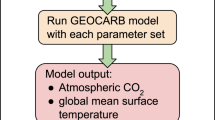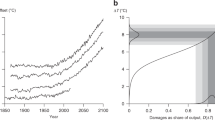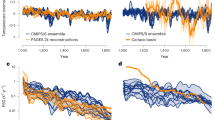Abstract
Despite Schneider's claim1, the method we use to estimate equilibrium climate sensitivity from multiple proxy-based reconstructions of the temperature in the Northern Hemisphere2 does account for uncertainty in reconstructions, including that associated with non-temperature and sampling error in the reconstruction. We arrive at a tighter constraint on climate sensitivity not by neglecting uncertainties, but by combining our wide-tailed proxy-based estimate with an independent estimate of climate sensitivity based on twentieth-century warming.
Similar content being viewed by others
Main
Schneider maintains that incomplete treatment of uncertainties in proxy reconstructions in our estimate yields an overly narrow estimate of equilibrium climate sensitivity1. This impression may have been caused by an inconsistency between the reconstruction erroneously attached to the Supplementary Information of ref. 2, which contained only uncertainty in the amplitude of the reconstruction, and its caption, which referred to both amplitude and sampling uncertainty (this error has now been corrected).
We account for uncertainty in temperature reconstructions as fully as possible. Our estimate of climate sensitivity is based on the sample variance of the residual Ti (using Schneider's terminology) between the proxy reconstruction and energy-balance model (EBM) simulations in response to external forcing. We estimate the probability that the difference between the minimum mean-squared residual and that the residual for any other parameter combination is due to noise by using the statistics Σiri (parameter)2 − Σi ri,min/v̄ar(ri,min) (refs 2, 3).
The residual variance is a sum of the sampled variances of internal climate variability, of non-temperature and spatial sampling noise of the reconstruction ηi, and of model error, which varies with model parameters. Therefore ηi, as sampled in each reconstruction (over hundreds of years), is part of the total residual variance and is accounted for in our estimate. Reconstructions with larger ηi yield larger residual variances, resulting in wider probability density functions for climate sensitivity. Our overall estimate of climate sensitivity from the last millennium is based on several reconstructions, which should have largely independent realizations of ηi, thus reducing dependence of our estimate on a particular realization of ηi.
Furthermore, the hypothetical example given by Schneider1 assumes a reconstruction that has zero variance over the reconstruction period, while varying randomly over the period of overlap with instrumental data. This example would yield numerical degeneracy in the statistic given here, whereas related examples with small preindustrial variance and poor correlations over the calibration period would yield very wide estimates of climate sensitivity owing to large uncertainty in β. Schneider's example violates the assumption that the relationship between proxy data and target of reconstruction can be estimated from the calibration period. It bears no resemblance to reconstructions used here, where the correspondence to (independently reconstructed) forcing is a strong indication that the reconstructions have skill over the pre-instrumental period4.
We stress that our overall result of a tighter constraint on climate sensitivity does not arise from palaeoclimatic reconstructions alone, which yield a very wide-tailed probability density function (see Fig. 3a of ref. 2). The tighter constraint arises from combining that estimate with an independent estimate of climate sensitivity based on climate change in the late twentieth century. As our sensitivity probability density function also broadly agrees with other, at least partly independent, evidence that we have not used5,6, we think that our estimate is conservative and valid, despite remaining uncertainties.
References
Schneider, T. Nature 446, doi: 10.1038/nature05707 (2007).
Hegerl, G. C., Crowley, T. J., Hyde, W. T. & Frame, D. J. Nature 440, 1029–1032 (2006).
Forest, C. E., Stone, P. H., Sokolov, A. P., Allen, M. R. & Webster, M. D. Science 295, 113–117 (2002).
Hegerl, G. C. et al. J. Climat. 20, 650–666 (2007).
Annan, J. D. & Hargreaves, J. C. Geophys. Res. Lett. 33, L06704 (2006).
Schneider von Deimling, T., Held, H., Ganopolski, A. & Rahmstorf, S. Climat. Dynam. 27, 149–163 (2006).
Author information
Authors and Affiliations
Rights and permissions
About this article
Cite this article
Hegerl, G., Crowley, T., Hyde, W. et al. Uncertainty in climate-sensitivity estimates (Reply). Nature 446, E2 (2007). https://doi.org/10.1038/nature05708
Published:
Issue Date:
DOI: https://doi.org/10.1038/nature05708
Comments
By submitting a comment you agree to abide by our Terms and Community Guidelines. If you find something abusive or that does not comply with our terms or guidelines please flag it as inappropriate.



